Gravely 250Z, 260Z User Manual
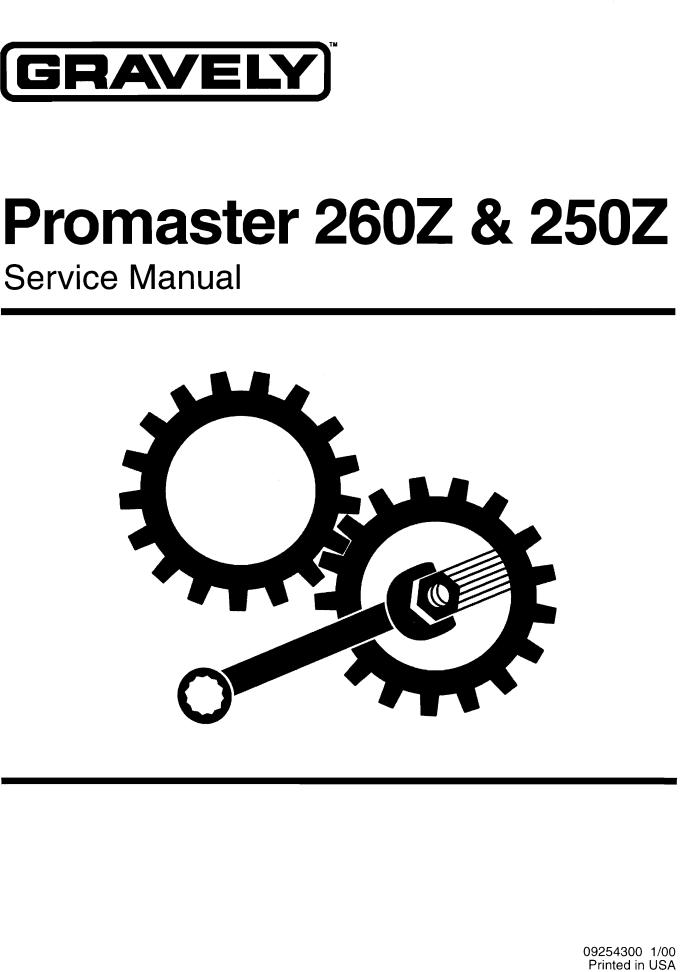

TABLE OF CONTENTS
Section 1 - Introduction . . . . . . . . . . . . . . . . . . 1-3
1.1 The Manual . . . . . . . . . . . . . . . . . . . . . . . . 1-3
1.2 Service and Replacement Parts . . . . . . . . 1-3
1.3 Product Registration . . . . . . . . . . . . . . . . . 1-3
1.4 Unauthorized Replacement Parts . . . . . . . 1-3
1.5 Disclaimer . . . . . . . . . . . . . . . . . . . . . . . . . 1-3
1.6 Technical Service Communications . . . . . . 1-3
1.7 Preparation . . . . . . . . . . . . . . . . . . . . . . . . 1-3
Section 2 - Safety . . . . . . . . . . . . . . . . . . . . . . . 2-4
2.1 Safety Alerts . . . . . . . . . . . . . . . . . . . . . . . 2-4
2.2 Signal Words . . . . . . . . . . . . . . . . . . . . . . . 2-4
2.3 Notations . . . . . . . . . . . . . . . . . . . . . . . . . . 2-4
2.4 Practices and Laws . . . . . . . . . . . . . . . . . . 2-4
2.5 Required Operator Training . . . . . . . . . . . . 2-4
2.6 Safety Rules. . . . . . . . . . . . . . . . . . . . . . . . 2-4
Section 3 - Specifications . . . . . . . . . . . . . . . . |
3-7 |
Section 4 - General Maintenance
& Adjustments . . . . . . . . . . . . . . . . . . . . . . . 4-8
4.1 Controls and Features . . . . . . . . . . . . . . . . 4-8
4.2 Service Position - 260Z . . . . . . . . . . . . . . . 4-9
4.3 Service Position - 250Z . . . . . . . . . . . . . . . 4-9
4.4 Moving the Unit-Engine Not Running. . . . . 4-9
4.5 Cleaning and Storage . . . . . . . . . . . . . . . . 4-9
4.6 Filling The Fuel Tank . . . . . . . . . . . . . . . . 4-10
4.7 Fasteners . . . . . . . . . . . . . . . . . . . . . . . . . 4-10
4.8 General Lubrication . . . . . . . . . . . . . . . . . 4-10
4.9 Basic Engine Maintenance . . . . . . . . . . . 4-11
4.10 Belts. . . . . . . . . . . . . . . . . . . . . . . . . . . . 4-11
4.11 Tires. . . . . . . . . . . . . . . . . . . . . . . . . . . . 4-12
4.12 Mower Blades . . . . . . . . . . . . . . . . . . . . 4-12
4.13 Steering Control Neutral Adjustment . . . 4-13
4.14 Adjusting Control Levers . . . . . . . . . . . . 4-13
4.15 Adjusting The Parking Brake . . . . . . . . . 4-14
4.16 Adjusting The Unit To Track Straight . . . 4-14
4.17 Leveling The Mower Deck . . . . . . . . . . . 4-15
Section 5 - Engine . . . . . . . . . . . . . . . . . . . . . . 5-16
5.1 Engine Troubleshooting . . . . . . . . . . . . . . 5-16
5.2 Removing the Engine. . . . . . . . . . . . . . . . 5-17
5.3 Installing The Engine . . . . . . . . . . . . . . . . 5-17
5.4 Electric Clutch . . . . . . . . . . . . . . . . . . . . . 5-17
Section 6 - Drive Train . . . . . . . . . . . . . . . . . . 6-18
6.1 Checking The Hydraulic Fluid Level. . . . . 6-18 6.2 Changing Hydraulic Fluid And Filter . . . . 6-18 6.3 Hydraulic Drive Flow Test. . . . . . . . . . . . . 6-18 6.4 Replacing The Hydraulic Pump . . . . . . . . 6-19 6.5 Replace Wheel Motor . . . . . . . . . . . . . . . 6-20 6.6 Hydraulic Deck Lift Pressure Test . . . . . . 6-21 6.7 Replace Lift Valve . . . . . . . . . . . . . . . . . . 6-21 6.8 Hydraulic Diagram . . . . . . . . . . . . . . . . . . 6-22
Section 7 - Mower Deck . . . . . . . . . . . . . . . . . 7-23
7.1 Mower Deck . . . . . . . . . . . . . . . . . . . . . . . 7-23
7.2 Anti-Scalp Rollers . . . . . . . . . . . . . . . . . . 7-23
Section 8 - |
Front Suspension . . . . . . . . . . . . |
8-24 |
Section 9 - |
Electrical . . . . . . . . . . . . . . . . . . . . |
9-25 |
9.1 Tools. . . . . . . . . . . . . . . . . . . . . . . . . . . . . 9-25
9.2 Electrical Measurements . . . . . . . . . . . . . 9-25
9.3 Battery . . . . . . . . . . . . . . . . . . . . . . . . . . . 9-26
9.4 Switches. . . . . . . . . . . . . . . . . . . . . . . . . . 9-28
9.5 Solenoid and Relays . . . . . . . . . . . . . . . . 9-29
9.6 Fuses . . . . . . . . . . . . . . . . . . . . . . . . . . . . 9-29
9.7 Diodes and Rectifiers. . . . . . . . . . . . . . . . 9-30
9.8 Wiring Diagrams . . . . . . . . . . . . . . . . . . . 9-31
2
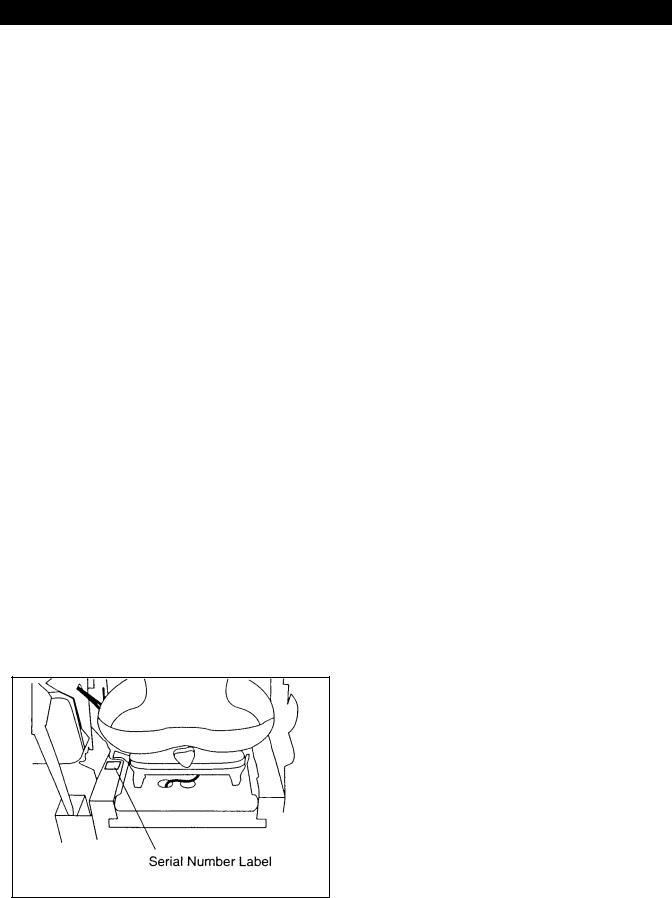
SECTION 1 - INTRODUCTION
1.1 THE MANUAL
The purpose of this manual is to provide complete instructions for service, maintenance, disassembly, repair, and installation of the mechanical components for the Promaster 260Z and 250Z.
Dealer trained service personnel should use this manual as a supplement to and reminder of the training sessions conducted by the company.
Read all information for servicing a part or system before repair work is started to avoid needless disassembly.
Operation
Before operation of the unit, carefully and completely read manuals supplied with the unit. The contents will provide you with an understanding of safety instructions and controls during normal operation and maintenance.
Safety Messages
For your safety and the safety of others always read, understand, and follow all DANGER, WARNING, and CAUTION messages found in manuals and on safety decals.
Directional Reference
All reference to left, right, front, or rear are given from the operator in the operator position and facing the direction of forward travel.
1.2 SERVICE AND REPLACEMENT PARTS
When ordering publications, replacement parts, or making service inquiries, know the Model and Serial numbers of your unit and engine.
Numbers are located on the product registration form in the unit literature package. They are printed on a serial number label, located on the frame of your unit.
Figure 1
1.3 PRODUCT REGISTRATION
A warranty registration card must be filled out, signed, and returned at time of purchase. This card activates the warranty. Claims meeting requirements during limited warranty period will be honored.
1.4 UNAUTHORIZED REPLACEMENT PARTS
Use only Gravely replacement parts. The replacement of any part on this vehicle with anything other than a Gravely authorized replacement part may adversely affect the performance, durability, or safety of this unit and may void the warranty. Gravely disclaims liability for any claims or damages, whether warranty, property damage, personal injury, or death arising out of the use of unauthorized replacement parts.
1.5 DISCLAIMER
Gravely reserves the right to discontinue, make changes to, and add improvements upon its products at any time without public notice or obligation. The descriptions and specifications contained in this manual were in effect at printing. Equipment described within this manual may be optional. Some illustrations may not be applicable to your unit.
1.6 TECHNICAL SERVICE COMMUNICATIONS
Ariens Technical Service communicates information to the field using Service Letters, Service Bulletins, Product Notices, and Campaigns. Each communication signifies a type of information and priority. The dealer is responsible to carry out the directive provided in the communication. The types of communication are:
Service Letter - General technical information for the dealer. Technical information on how to service the product and product improvements.
Service Bulletin - Notification to update products to resolve certain issues or a notification of a policy change.
Product Notices - Notification of limited product located in a certain region. This is a limited distribution to only those who received the product involved.
Campaigns - Notification of a safety related issue. All products must be updated and are tracked by the factory until all units are corrected.
1.7 PREPARATION
Before starting any removal of parts, proper preparation is very important for efficient work. A clean work area at the start of each job will allow you to perform service repairs easily and quickly.
1 - 3
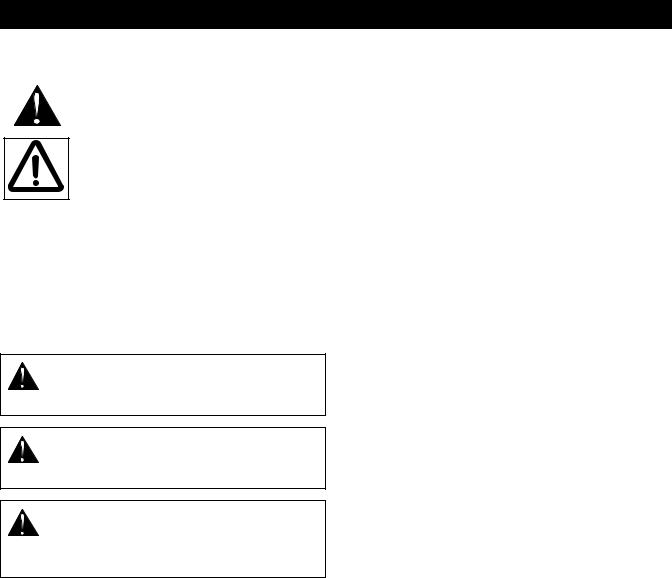
To reduce the incidence of misplaced tools or parts, place removed components with all attaching hardware in the disassembly order on a clean work surface. Organization is a key part of proper reassembly.
Tools, instruments, and parts needed for the job should be gathered before work is started. Interrupting a job to locate tools or parts is a needless delay.
SECTION 2 - SAFETY
2.1 SAFETY ALERTS
Look for these symbols to point out important safety precautions. They mean:
Attention!
Personal Safety Is Involved!
Become Alert!
Obey The Message!
2.2 SIGNAL WORDS
The safety alert symbol is used in decals on the unit and with proper operation procedures in this manual. They alert you to the existence and relative degree of hazards.
Understand the safety message. It contains important information about personal safety on or near the unit.
DANGER: IMMINENTLY HAZARDOUS SITUATION! If not avoided, WILL RESULT in death or serious injury.
WARNING: POTENTIALLY HAZARDOUS SITUATION! If not avoided, COULD RESULT in death or serious injury.
CAUTION: POTENTIALLY HAZARDOUS SITUATION! If not avoided, MAY RESULT in minor or moderate injury. It may also be used to alert against unsafe practices.
2.3 NOTATIONS
NOTE: General reference information for proper operation and maintenance practices.
IMPORTANT: Specific procedures or information required to prevent damage to unit or attachment.
2.4 PRACTICES AND LAWS
Practice usual and customary safe working precautions, for the benefit of yourself and others. Understand and follow all safety messages. Be alert to unsafe conditions and the possibility of minor, moderate, or serious injury or death. Learn applicable rules and laws in your area.
2.5 REQUIRED OPERATOR TRAINING
Original purchaser of this unit was instructed by the seller on safe and proper operation. If unit is to be used by someone other than original purchaser; loaned, rented or sold, ALWAYS provide the Operator’s Manual and any needed safety training before operation.
2.6 SAFETY RULES
Walk Around Inspection
Complete a walk around inspection of unit and work area to understand:
•Work area.
•Your unit.
•All safety decals.
Work Area
ALWAYS check overhead and side clearances carefully before operation. ALWAYS be aware of traffic when operating along streets or curbs.
ALWAYS keep hands and feet within the limits of the unit.
Keep children, people, and animals away. Keep children out of work area and under watchful care of a responsible adult.
Keep area of operation clear of all toys, pets, and debris. Objects can cause vehicle instability and injury.
Check for weak spots on dock, ramps or floors. Avoid uneven work areas and rough terrain. Stay alert for hidden hazards.
DO NOT run engine in an enclosed area. Always provide good ventilation.
Unit
ALWAYS keep protective structures, guards, and panels in good condition, in place and securely fastened. NEVER modify or remove safety devices.
Check Safety Interlock System for proper operation daily (see Operation section). Do not operate unless system operates properly.
2 - 4
Operation
Understand:
•How to operate all controls
•The functions of all controls
•How to STOP in an Emergency
•Speed ranges
Do not operate any of the control levers or power takeoff unless both feet are resting on the platform.
DO NOT travel at too fast a rate. DO NOT change engine governor settings or over-speed engine.
Always back up slowly. Always look down and behind before and while backing.
Never leave a running unit unattended. ALWAYS shut off power take off, lower throttle setting, and stop engine before leaving unit. ALWAYS remove key to prevent unauthorized use.
Never carry passengers on any part of unit.
Avoid uneven and rough terrain. DO NOT operate near drop offs, ditches, or embankments. Unit can suddenly turn over if a wheel is over the edge of a cliff or ditch, or if an edge caves in.
If tires lose traction, turn off power take off and proceed slowly straight down slope. Avoid wet surfaces.
Avoid parking on a slope. If necessary, use wheel chocks.
DO NOT leave unit unattended on a slope. ALWAYS use wheel chocks when leaving unit.
ALWAYS operate unit in good visibility and light.
Fuel is highly flammable and its vapors can explode. Use ONLY approved fuel containers.
NO Smoking!
NO Sparks!
NO Flames!
Allow engine to cool before servicing.
NEVER fill fuel tank when engine is running, hot, or unit is indoors.
Abnormal Vibrations are a warning of trouble. Striking a foreign object can damage unit. Immediately stop unit and engine. Remove key and wait for all moving parts to stop. Remove wire from spark plug. Inspect unit and make any necessary repairs before restart.
Hazardous Slopes
DO NOT operate on steep slopes. Avoid operating on slopes. When you must operate on a slope, travel up and down the slope. Never operate across a slope.
Never operate on a slope greater than 10 degrees.
Child Safety
NEVER allow children to operate or play on or near unit. Be alert and shut off unit if children enter area.
Personal Safety
Read and obey all warning, caution, and instructions on the unit and in provided manuals.
•Only trained adults may operate unit.
•Training includes actual operation.
•Clearly understand instructions.
•Be alert! Conditions can change.
NEVER operate unit after or during the use of medication, drugs or alcohol. Safe operation requires your complete and unimpaired attention at all times.
NEVER allow anyone to operate the unit when their alertness or coordination is impaired.
DO NOT operate unit without wearing adequate outer garments. Wear adequate safety gear and protective gloves. Wear proper footwear to improve footing on slippery surfaces.
Protect eyes, face, and head from objects that may be thrown from unit. Wear appropriate hearing protection.
Avoid Sharp Edges. Sharp edges can cut. Moving parts can cut or amputate fingers or a hand. Wear gloves to service unit when handling sharp edges.
ALWAYS keep hands away from any pinch points.
ALWAYS keep hands and feet away from all moving parts during operation. Moving parts can cut off body parts.
DO NOT touch unit parts which might be hot from operation. Allow parts to cool before attempting to maintain, adjust, or service.
Controls
Come to a complete stop before reversing.
Never jerk the control levers. Always use a steady even action to achieve smooth control.
Always be aware of obstructions that may cause injury to operator or damage to the unit.
Maintenance
ALWAYS maintain unit in safe operating condition. Damaged or worn out muffler can cause fire or explosion.
Check the conditions of the unit at the end of each day and repair any damage or defects.
ALWAYS block wheels and know all jack stands are strong and secure and will hold weight of unit during maintenance.
Keep nuts and bolts tight and keep equipment in safe operating conditions.
Before maintenance, adjustments, or service (except where specifically recommended), shut off engine.
Allow hot parts to cool.
Keep unit free of dirt, stones, and other debris. Clean up oil or fuel spills.
2 - 5
Storage
DO NOT store unit inside a building with fuel in the fuel tank where any ignition sources are present. Allow unit to cool completely.
ALWAYS clean unit before extended storage. See Engine Manual for proper storage.
Battery
Avoid Electric Shock. DO NOT reverse battery connections.
Explosive Gases! Poisonous battery fluid contains sulfuric acid and its contact with skin, eyes, or clothing can cause severe burns.
No flames. No sparks. No smoking near battery.
Always wear safety glasses and protective gear near battery.
DO NOT TIP battery beyond a 45o angle in any direction.
ALWAYS KEEP BATTERIES OUT OF REACH of children.
Transport
Use extra care when loading or unloading unit onto trailer or truck. Secure unit chassis to transport vehicle. NEVER secure from rods or linkages that could be damaged.
DO NOT transport with attachment in raised position.
Lower attachment when unit is parked or stored unless a positive mechanical lock is used.
Attachments and Accessories
Use only attachments or accessories designed for your unit.
2 - 6

SECTION 3 - SPECIFICATIONS
Model Number |
992020 and 022 |
992018 |
|
992021 |
|
992023 |
992024 |
Model |
PM260Z 25 HP |
PM260Z 25 HP |
|
PM260Z 22 HP |
|
PM250Z 20HP |
PM260Z 22 HP |
|
Kohler with |
Kohler with |
|
Robin with |
|
Briggs & |
Robin with |
|
60" deck |
50" deck |
|
50" deck |
|
Stratton with |
60" deck |
|
|
|
|
|
|
50" deck |
|
|
|
|
|
|
|
|
|
Length - cm (in) |
|
229 (90)* |
|
|
|
221 (87) |
229 (90)* |
|
|
|
|
|
|
|
|
Height - cm (in) |
|
|
127 (50) |
|
|
|
|
|
|
|
|
|
|
|
|
Width - cm (in) |
185 (73) |
|
160 (63) |
|
|
185 (73) |
|
|
|
|
|
|
|
|
|
Weight Actual - kg (lbs) |
510 (1125) |
499 (1100) |
|
500 (1103) |
|
490 (1080) |
511 (1128) |
|
|
|
|
|
|
|
|
Battery |
|
|
|
12 volt |
|
|
|
|
|
|
|
||||
Brakes |
|
Hydro/Dynamic Disk - Parking |
|
||||
|
|
|
|
|
|
|
|
Turning Radius |
|
|
0 |
|
|
|
|
|
|
|
|
|
|
|
|
Tire Size Front |
|
15 x 6 - 6 |
|
|
|
15 x 6 - 6 |
15 x 6 - 6 |
Rear |
|
23 x 10.5 - 12 |
|
|
|
23 x 8.5 - 12 |
23 x 10.5 - 12 |
|
|
|
|
|
|
|
|
|
|
|
|
|
|
|
|
Engine - manufacturer |
Kohler |
Kohler |
|
Robin |
|
Briggs & Stratton |
Robin |
|
|
|
|
|
|
|
|
Model Number |
CV25S |
CV25S |
|
EH65V |
|
35177 |
EH65V |
|
|
|
|
|
|
|
|
Cycle |
|
|
4 |
|
|
|
|
|
|
|
|
|
|
|
|
Engine Power - |
25 HP |
25 HP |
|
22 HP |
|
20 HP |
22 HP |
HP (KW/min -1) |
(18.4 KW/min -1) |
(18.4 KW/min -1) |
|
(16.2 KW/min -1) |
|
(14.7 KW/min -1) |
(16.2 KW/min -1) |
Starting System |
|
|
|
Electric |
|
|
|
|
|
|
|
|
|
||
Fuel Tank Capacity |
|
|
9 gals. US (34 liters) |
|
|
||
|
|
|
|
|
|
||
Fuel |
|
|
See Engine Manual |
|
|
||
|
|
|
|
|
|
|
|
Idle RPM |
|
|
1800 |
|
|
|
|
|
|
|
|
|
|
|
|
Governed RPM |
|
|
3600 |
|
|
|
|
|
|
|
|
||||
Air Cleaner |
|
Large Capacity Dual Element |
|
||||
|
|
|
|
|
|
|
|
Cooling Capacity |
|
|
|
Air Cooled |
|
|
|
|
|
|
|
|
|
||
Engine Oil Type |
|
|
See Engine Manual |
|
|
||
|
|
|
|
|
|
||
Spark Plug Gap |
|
|
See Engine Manual |
|
|
||
|
|
|
|
|
|
|
|
Transmission |
|
|
|
Hydrostatic Drive |
|
|
|
|
|
|
|
|
|
|
|
Speed - Forward Max. |
|
|
|
9 MPH |
|
|
|
Reverse Max. |
|
|
|
4.5 MPH |
|
|
|
|
|
|
|
||||
Transmission Lube |
|
Mobil 1 15W-50 Synthetic |
|
||||
|
|
|
|
|
|
|
|
Drive Clutch |
|
|
|
Hydrostatic |
|
|
|
|
|
|
|
|
|
|
|
Tire Pressure Front |
|
|
|
20-25 psi |
|
|
|
Rear |
|
|
|
12-15 psi |
|
|
|
|
|
|
|
|
|
|
|
Lift System |
|
|
|
Hydraulic |
|
|
|
|
|
|
|
||||
Power Take Off |
|
Electric PTO Clutch/Brake |
|
||||
|
|
|
|
|
|
|
|
Mower Deck |
|
|
|
High Performance |
|
|
|
|
|
|
|
|
|
|
|
Cutting Width - cm (in) |
152 (60) |
|
127 (50) |
|
|
152 (60) |
|
|
|
|
|
|
|
|
|
Cutting Height - cm (in) |
|
|
2.5 - 12.7 (1 - 5) |
|
|
|
|
|
|
|
|
||||
Cut Increments - cm (in) |
|
Infinite between 2.5 - 12.7 (1 - 5) |
|
||||
|
|
|
|
|
|
|
|
3 - 7
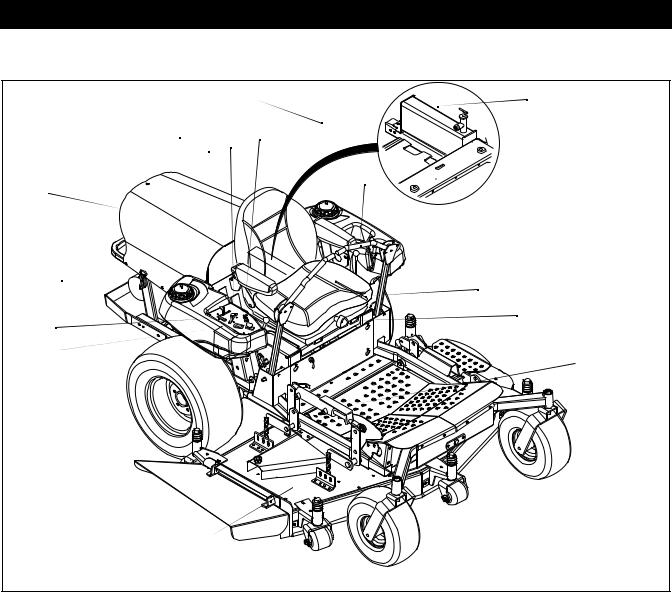
SECTION 4 - GENERAL MAINTENANCE & ADJUSTMENTS
4.1 CONTROLS AND FEATURES
|
8 |
18 |
|
|
11 |
9 |
10 |
12 |
|
||
7 |
|
13 |
|
|
|
|
|
14 |
19 |
|
15 |
|
|
|
6 |
|
16 |
|
|
|
5 |
|
17 |
4 |
|
|
|
|
|
3 |
|
|
2 |
|
|
20 |
|
|
1 |
|
|
|
|
OF1722 |
|
|
Figure 2 |
1. |
Mower Deck with Chute Deflector |
11. |
Ignition Switch |
2. |
Fuel Shut Off Valve |
12. |
Power Take Off (PTO) Switch |
3. |
Parking Brake |
13. |
Steering Levers |
4. |
Battery |
14. |
Mower Lift Lever |
5. |
Hour Meter |
15. |
Seat Adjustment Lever |
6. |
Oil Pressure Indicator |
16. |
Seat Suspension Adjustment Knob (260Z) |
7. |
Engine Frame and Hood (260Z) |
17. |
Height of Cut Indicator |
8. |
Fuel Tanks and Caps |
18. |
Hydraulic Oil Reservoir |
9. |
Choke Control |
19. |
Engine Hood Latch (260Z) |
10. |
Throttle Control |
20. |
Foot Board Latch |
* Serial No. 010000 and up are 221 (87)
4 - 8
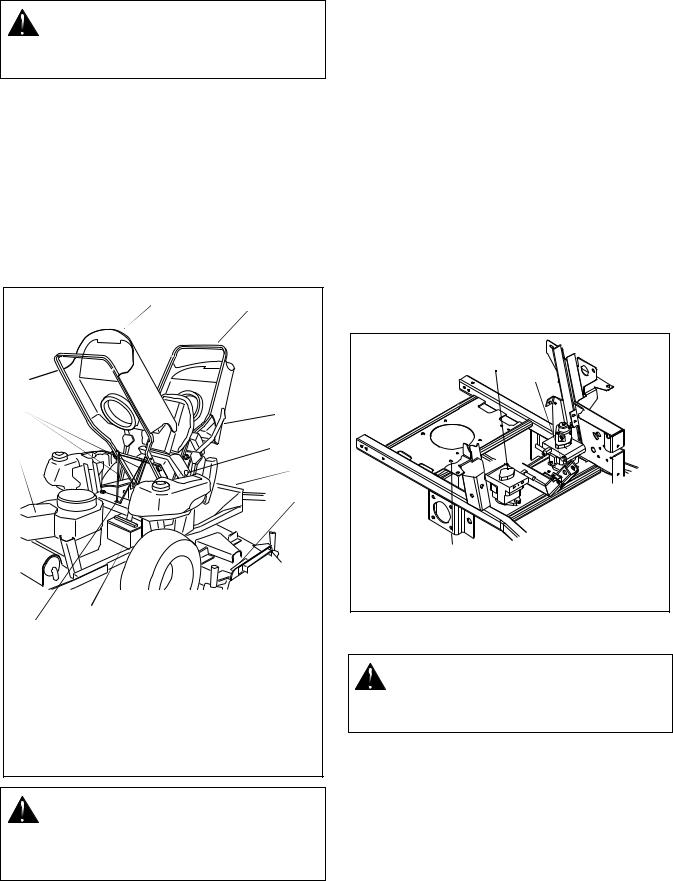
4.2 SERVICE POSITION - 260Z
WARNING: ALWAYS block wheels and know that jack stands or blocks used are stable, strong, or secure and will hold the weight of the unit during maintenance.
To ensure the unit is positioned in the proper service position:
1.Place unit on a flat level surface. ALWAYS stop engine. Assure unit is secure and will not tip over. Strap and clamp onto lift if used.
2.Place steering levers in neutral position and set parking brake.
3.Unhook hood latches.
4.Firmly grasp engine frame and cover. Lift to desired service position (Figure 3).
|
|
|
7 |
8 |
|
|
|
|
|
4 |
|
|
|
|
5 |
|
|
|
1 |
9 |
|
|
|
2 |
|
|
|
|
|
|
|
|
|
3 |
|
|
|
|
10 |
|
6 |
11 |
|
|
|
|
|
|
|
1. |
Steering Levers |
|
7. Daily Service Position |
|
2. |
Parking Brake |
|
8. Full Service Position |
|
3. |
Footboard |
|
|
9. Engine |
4. |
Engine Hood & Frame |
|
10. No Step Decal |
|
5. |
Engine Hood Prop Rod |
|
11. Battery |
|
6. |
Service Slot |
|
|
|
|
|
Figure 3 |
||
|
|
|
|
OF1811 |
CAUTION: WHEN OPENING ENGINE COVER, USE CARE TO PROPERLY ENGAGE PROP INTO SLOT. Be sure footing is secure to accommodate weight shift of hood when rotating to full service position.
Daily Service Position: Place engine hood prop rod into service slot. Assure rod is engaged in slot properly.
Full Service Position: Slowly release frame after seat contacts foot board. Use care and be sure of your footing. Do not step on mower deck.
5.When service is complete, lower hood and secure with latches.
4.3 SERVICE POSITION - 250Z
Firmly grasp seat frame handle and lift past vertical. Lay inverted seat on foot rest. When service is complete, return seat to upright position.
4.4 MOVING THE UNIT-ENGINE NOT RUNNING
To move the unit without the engine running, rotate the bypass valve levers located on the pumps toward the center of the tractor approximately 1/2 turn using a wrench. Levers must be returned to their original position in order to operate the unit (Figure 4).
|
2 |
|
|
1 |
|
1. |
Left Bypass Valve Lever |
|
2. |
Right Bypass Valve Lever |
|
|
Figure 4 |
OF1730 |
|
|
4.5 CLEANING AND STORAGE
WARNING: AVOID SHARP EDGES which can cut. Movement of parts can cut off fingers or a hand. Wrap blades, wear gloves, and use extreme caution when servicing.
IMPORTANT: Never spray unit with water or store unit outdoors to help prevent sealed bearing rust or corrosion. Water can seep into sealed bearings and reduce component life. Bearings are sealed against dirt and debris only.
A unit that is excessively dirty should be cleaned before work starts. Cleaning will occasionally uncover trouble sources. Dirt and abrasive dust reduce the efficient work life of parts and can lead to costly replacement.
4 - 9
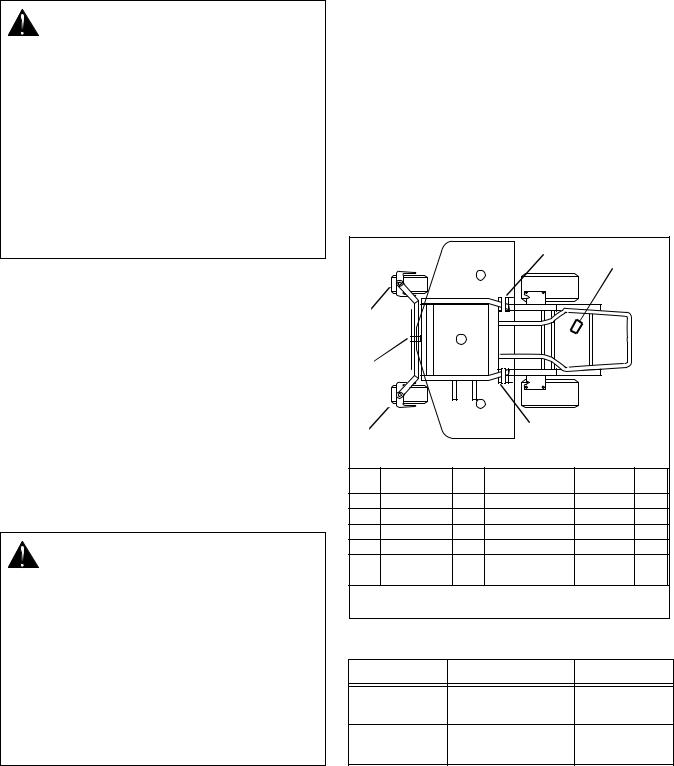
When taking unit out of extended storage:
1.Check for any damage or loose parts. Repair, replace, or tighten hardware before operation, especially blade attachment bolts.
2.If a preservative fluid was used in fuel tank, drain and discard. Fill fuel tank with fresh new fuel.
4.6 FILLING THE FUEL TANK
EXPLOSIVE VAPORS and FLAMMABLE FUEL can result in serious injury or death. Handle fuel with care. ALWAYS use an approved fuel container.
No Smoking!
No Lighted Materials!
No Open Flame!
Allow engine to cool.
Use caution with fuel. Fuel is very flammable. Keep fuel in a clean and tight container. Keep fuel away from fire or heat. Never put fuel in the fuel tank while the engine is running or hot. Clean up any spilled fuel before starting the engine.
Add fuel to the tank as needed. See your Engine Manual for correct type and grade of fuel.
To add fuel to the fuel tank:
1.Refuel the unit only in a well ventilated, open area.
2.Stop the engine.
3.Clean the fuel cap and the area around the fuel cap to prevent dirt from entering the fuel tank. Remove the cap from the fuel tank.
4.Fill the fuel tank. Be careful not to spill the fuel. Do not overfill, allow for fuel expansion. Stop filling when fuel is about 1” below the bottom of the neck.
5.Install the cap on the fuel tank and tighten.
6.Clean up any spilled fuel before starting the engine.
WARNING: POTENTIAL HAZARDOUS! Fuel is extremely flammable and highly explosive. Personal injury and property damage may result if not handled properly.
•Fill the fuel tank outdoors in an open area. Do not fill when the engine is hot. Wipe up any fuel spills.
•Never fill the fuel tank completely full. Empty space in tank allows fuel to expand.
•Never smoke when handling fuel. Stay away from open flames. Fuel fumes can be ignited by sparks.
4.7 FASTENERS
Each day before operating, check mower blade mounting hardware and all other fasteners. Replace fasteners that are missing or damaged. Tighten all nuts and bolts to their correct torque value.
4.8 GENERAL LUBRICATION
IMPORTANT: Wipe each fitting clean before and after lubrication.
Lube fitting locations are:
-each deck push arm (2)
-Hydro Idler (1)
-front axle pivot (1)
Apply Sten Mix Hi-Temp Grease or equivalent to the lube fittings. Order P/N: 00036700ten pack of 14 oz. cartridges.
When using Sten Mix Hi-Temp Grease for the first time, all components should be thoroughly cleaned prior to lubricating.
Apply oil at all pivot points and pin connections.
|
|
|
4 |
|
|
|
|
|
|
1 |
|
2 |
|
|
|
|
|
3 |
|
|
|
|
|
2 |
|
|
3 |
|
|
REF |
LUBRICATION |
QTY |
DESCRIPTION- |
INTERVAL |
REF |
|
|
|
LOCATION |
|
|
|
|
|
|
|
|
1 |
GREASE |
2 |
CASTER PIVOT |
50 Hrs. |
1 |
2 |
GREASE |
1 |
AXLE PIVOT |
400 Hrs |
2 |
3 |
GREASE |
2 |
PUSH ARM PIVOT |
50 Hrs |
3 |
4 |
GREASE |
1 |
PUSH ARM PIVOT |
50 Hrs |
4 |
|
OIL |
|
ALL PIVOT POINTS, |
50 Hrs |
|
|
|
|
PIN CONNECTIONS |
|
|
|
|
|
Figure 5 |
|
OF1791 |
|
|
|
|
|
|
Description |
|
Use |
Interval |
||
Grease fittings |
Sten Mix Hi-Temp |
50 hrs. running |
|||
|
|
grease or equivalent |
time |
|
|
Hydraulic |
Mobil 15W50 |
500 hrs running |
|||
system |
synthetic oil |
time |
|
||
4 - 10
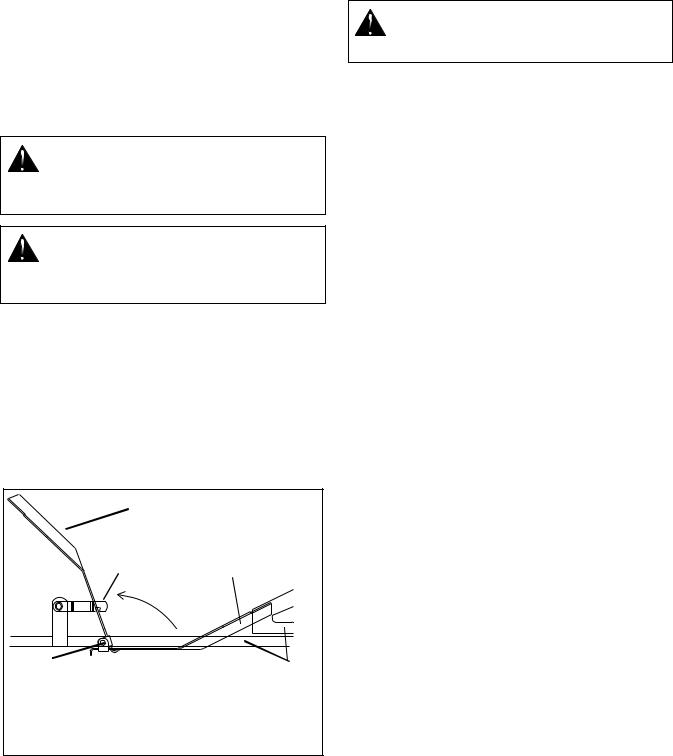
4.9 BASIC ENGINE MAINTENANCE
See your engine manual and Section 5 of this manual for detailed information on the operation and maintenance of your engine.
1.Each day before operating, check the level of the oil in the engine. Never operate the engine when the oil level is below the add mark.
2.Each day before operating, check the air cleaner element. Dirt can decrease the flow of air to the engine.
3.Each day before operating, check the air cooling system on the engine. Debris can decrease the flow of air cooling the engine.
4.Follow the maintenance instructions in your engine manual concerning oil and filter changes.
4.10 BELTS
WARNING: MOVING PARTS can cut or amputate body parts. ALWAYS wait for moving parts to stop before performing maintenance or service.
CAUTION: DAMAGED OR WORN BELTS may result in injury and/or damage to the unit. Check belts for excessive wear or cracks often.
Belt Access
1.Properly stop and park unit (refer to Owner’s Manual).
2.Lower the mower.
3.Place seat in most rearward position.
4.Remove belt covers.
5.Place foot board in open position (Figure 6).
6.Secure raised footboard with latch.
Replacing Mower Belts
NOTE: Long belt must be removed to remove short belt.
1.Roll long belt off left blade spindle and remove from deck.
2.Roll short belt off right blade spindle and remove from deck. Idler pivot bolt must be loosened slightly to gain clearance to remove belt from under idler pulley (Figure 7).
CAUTION: Use care when releasing idler spring tension. Keep body parts well away from idlers when performing this operation.
3.Arrange new mower belt(s) on deck (short belt first). Retighten short belt idler pivot bolt. Install belts on sheaves. Roll belts onto blade sheave last.
4.Replace belt covers and return foot board to closed position.
Replacing the Hydro Pump Belt
1.Properly stop and park unit (refer to unit Owner’s Manual).
2.Remove the mower belt from the mower clutch sheave. See Replacing Mower Belts.
3.Remove old hydro pump belt by rolling belt off right hand hydrostat sheave first (Figure 8).
4.Install new pump belt by positioning belt on sheaves. Roll belt onto right hand hydrostat sheave last.
5.Put the mower belt back on mower clutch sheave. See Replacing Mower Belts.
|
1 |
|
5 |
|
2 |
|
|
|
4 |
|
3 |
|
|
|
1. Footboard in open |
3. |
Support Frame |
position |
4. |
Pivot |
2. Footboard in closed |
5. |
Latch |
position |
|
|
|
Figure 6 |
OF1802 |
|
|
4 - 11 |
